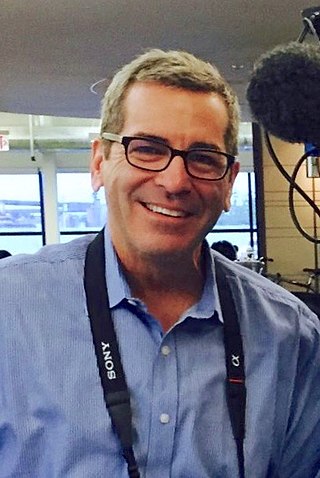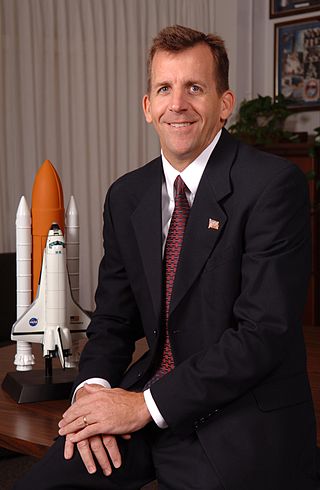Related Research Articles

Space Shuttle Endeavour is a retired orbiter from NASA's Space Shuttle program and the fifth and final operational Shuttle built. It embarked on its first mission, STS-49, in May 1992 and its 25th and final mission, STS-134, in May 2011. STS-134 was expected to be the final mission of the Space Shuttle program, but with the authorization of STS-135 by the United States Congress, Atlantis became the last shuttle to fly.

The Space Shuttle program was the fourth human spaceflight program carried out by the U.S. National Aeronautics and Space Administration (NASA), which accomplished routine transportation for Earth-to-orbit crew and cargo from 1981 to 2011. Its official program name was Space Transportation System (STS), taken from a 1969 plan for a system of reusable spacecraft where it was the only item funded for development, as a proposed nuclear shuttle in the plan was cancelled in 1972. It flew 135 missions and carried 355 astronauts from 16 countries, many on multiple trips.

Space tourism is human space travel for recreational purposes. There are several different types of space tourism, including orbital, suborbital and lunar space tourism. Tourists are motivated by the possibility of viewing Earth from space, feeling weightlessness, experiencing extremely high speed and something unusual, and contributing to science.

The Canadian Space Agency is the national space agency of Canada, established in 1990 by the Canadian Space Agency Act.

The Rogers Commission Report was written by a Presidential Commission charged with investigating the Space Shuttle Challenger disaster during its 10th mission, STS-51-L. The report, released and submitted to President Ronald Reagan on June 9, 1986, determined both the cause of the disaster that took place 73 seconds after liftoff, and urged NASA to improve and install new safety features on the shuttles and in its organizational handling of future missions.

Charles Frank Bolden Jr. is a former Administrator of NASA, a retired United States Marine Corps Major General, and a former astronaut who flew on four Space Shuttle missions.

Robert Joseph "Bob" Cenker is an American aerospace and electrical engineer, aerospace systems consultant, and former astronaut. Cenker worked for 18 years at RCA Astro-Electronics, and its successor company GE Astro Space, on a variety of spacecraft projects. He spent most of his career working on commercial communications satellites, including the Satcom, Spacenet and GStar programs.

Richard Alan "Rick" Searfoss was an American aviator who was United States Air Force colonel, NASA astronaut and test pilot.

The Vision for Space Exploration (VSE) was a plan for space exploration announced on January 14, 2004 by President George W. Bush. It was conceived as a response to the Space Shuttle Columbia disaster, the state of human spaceflight at NASA, and as a way to regain public enthusiasm for space exploration.

Private spaceflight refers to spaceflight developments that are not conducted by a government agency, such as NASA or ESA.

Michael Douglas Griffin is an American physicist and aerospace engineer who served as the Under Secretary of Defense for Research and Engineering from 2018 to 2020. He previously served as deputy of technology for the Strategic Defense Initiative, and as administrator of NASA from April 13, 2005, to January 20, 2009. As NASA administrator, Griffin oversaw such areas as private spaceflight, future human spaceflight to Mars, and the fate of the Hubble telescope.

Soichi Noguchi is a Japanese aeronautical engineer and former JAXA astronaut. His first spaceflight was as a mission specialist aboard STS-114 on 26 July 2005 for NASA's first "return to flight" Space Shuttle mission after the Columbia disaster. He was also in space as part of the Soyuz TMA-17 crew and Expedition 22 to the International Space Station (ISS), returning to Earth on 2 June 2010. He is the sixth Japanese astronaut to fly in space, the fifth to fly on the Space Shuttle, and the first to fly on Crew Dragon.

Miles O'Brien is an independent American broadcast news journalist specializing in science, technology, and aerospace who has been serving as national science correspondent for PBS NewsHour since 2010.

John Cornelius Houbolt was an aerospace engineer credited with leading the team behind the lunar orbit rendezvous (LOR) mission mode, a concept that was used to successfully land humans on the Moon and return them to Earth. This flight path was chosen for the Apollo program in July 1962. The critical decision to use LOR was viewed as vital to ensuring that man reached the Moon by the end of the decade as proposed by President John F. Kennedy. In the process, LOR saved time and billions of dollars by efficiently using the available rocket and spacecraft technologies.

George Edwin Mueller, was an American electrical engineer who was an associate administrator at NASA, heading the Office of Manned Space Flight from September 1963 until December 1969. Hailed as one of NASA's "most brilliant and fearless managers", he was instrumental in introducing the all-up testing philosophy for the Saturn V launch vehicle, which ensured the success of the Apollo program in landing a man on the Moon and returning him safely to the Earth by the end of 1969. Mueller also played a key part in the design of Skylab, and championed the Space Shuttle's development, which earned him the nickname, "the father of the Space Shuttle."

LeRoy Edward Cain is an American aerospace engineer who worked for NASA as a flight director, launch integration manager and deputy manager of the Space Shuttle Program. Cain may be best known to the public from footage and documentaries showing his work as the entry flight director for STS-107, the mission that ended in the catastrophic disintegration of Space Shuttle Columbia, February 1, 2003. Cain issued the famous "Lock the doors" command, initiating contingency procedures in mission control for the first time since the Space Shuttle Challenger disaster 17 years earlier.

The National Aeronautics and Space Administration is an independent agency of the US federal government responsible for the civil space program, aeronautics research, and space research. Established in 1958, it succeeded the National Advisory Committee for Aeronautics (NACA) to give the US space development effort a distinct civilian orientation, emphasizing peaceful applications in space science. It has since led most of America's space exploration programs, including Project Mercury, Project Gemini, the 1968–1972 Apollo Moon landing missions, the Skylab space station, and the Space Shuttle. Currently, NASA supports the International Space Station (ISS) along with the Commercial Crew Program, and oversees the development of the Orion spacecraft and the Space Launch System for the lunar Artemis program.

The National Space Council is a body within the Executive Office of the President of the United States created in 1989 during the George H. W. Bush administration, disbanded in 1993, and reestablished in June 2017 by the Donald Trump administration. It is a modified version of the earlier National Aeronautics and Space Council (1958–1973).

Livingston L. Holder Jr. is a former USAF astronaut in the Manned Spaceflight Engineer Program during the mid-1980s. He was assigned to fly as a military payload specialist on the Space Shuttle, but could not fly in space due to the Challenger accident in 1986.
Robert E. "Rob" Meyerson is an American aerospace engineer and executive.
References
- ↑ "Capitol Alliance Solutions". courtney-stadd.squarespace.com. Retrieved 2024-12-18.
- ↑ "Former NASA Exploration Chief Gets Nod as Next NASA Administrator". Space.com. 11 March 2005. Retrieved 3 December 2015.
- 1 2 "Former NASA Chief of Staff Begins Jail Term". Space.com. 9 February 2011.
- 1 2 Ruoff, Alex (November 24, 2010). "Bethesda man sentenced for stealing from NASA; Former chief of staff sentenced for conspiracy". The Gazette. Archived from the original on July 23, 2012. Retrieved June 27, 2012.
- 1 2 "Former NASA chief of staff pleads guilty to conspiracy charge". Government Executive. 23 August 2010.
- 1 2 "Ex-Nasa Official Guilty of Conspiracy". The New York Times. August 18, 2010.
- ↑ "The National Space Institute". nss.org. Archived from the original on 8 December 2015. Retrieved 3 December 2015.
- ↑ The Space Humanization Series: Institute for the Social Science Study of Space, T. Stephen Cheston, David C. Webb, Courtney A. Stadd: 9780934144018. ISBN 093414401X.
- ↑ "Reaching for the High Frontier: Chapter 12". nss.org. Archived from the original on 2015-01-20. Retrieved 2015-01-20.
- ↑ "Unknown Title" (PDF).[ permanent dead link ]
- ↑ "Launches". faa.gov. Retrieved 3 December 2015.
- ↑ "courtney stadd - JSC History Portal Search Results". nasa.gov. Retrieved 3 December 2015.
- ↑ "Chief Of Staff Courtney Stadd Announces Plans To Leave Agency". NASA Newsroom. May 27, 2003. Archived from the original on 24 August 2021. Retrieved 2 January 2017.
- ↑ "NASA Strategic Management Handbook". nasa.gov. Archived from the original on 2013-10-23. Retrieved 2015-01-20.
- ↑ "Courtney A. Stadd". IMDb. Retrieved 3 December 2015.
- ↑ "Space Shuttle Columbia: Mission of Hope". Space Shuttle Columbia: Mission of Hope - PBS. Archived from the original on 5 December 2015. Retrieved 3 December 2015.
- ↑ "U.S. Office of Government Ethics - LA-11-08: 2010 Conflict of Interest Prosecution Survey". usoge.gov. Archived from the original on 2012-12-14.
- ↑ "United States v. Stadd, 636 F.3d 630 (D.C. Cir. 2011)". Archived from the original on 2011-03-07.
- ↑ "Inmate Locator". bop.gov.[ permanent dead link ]